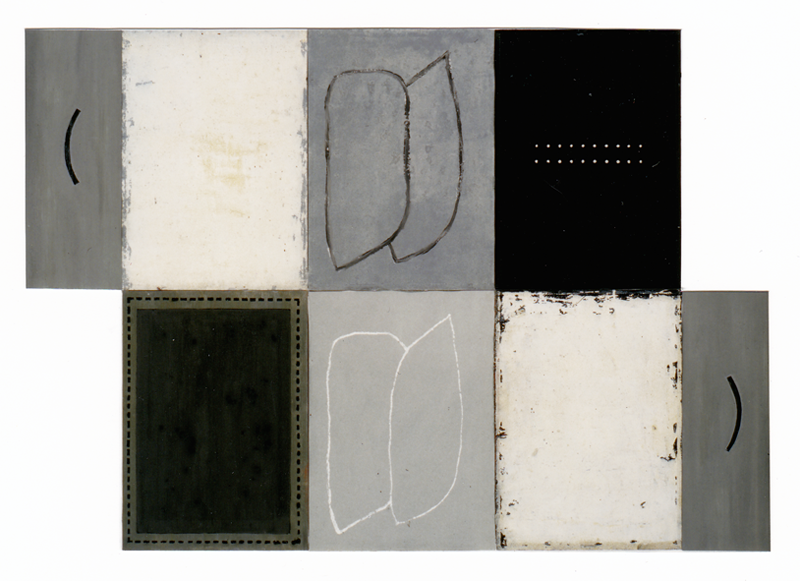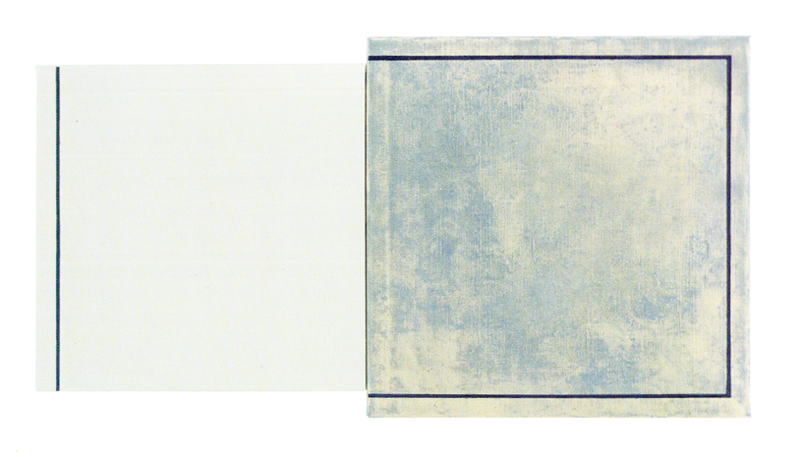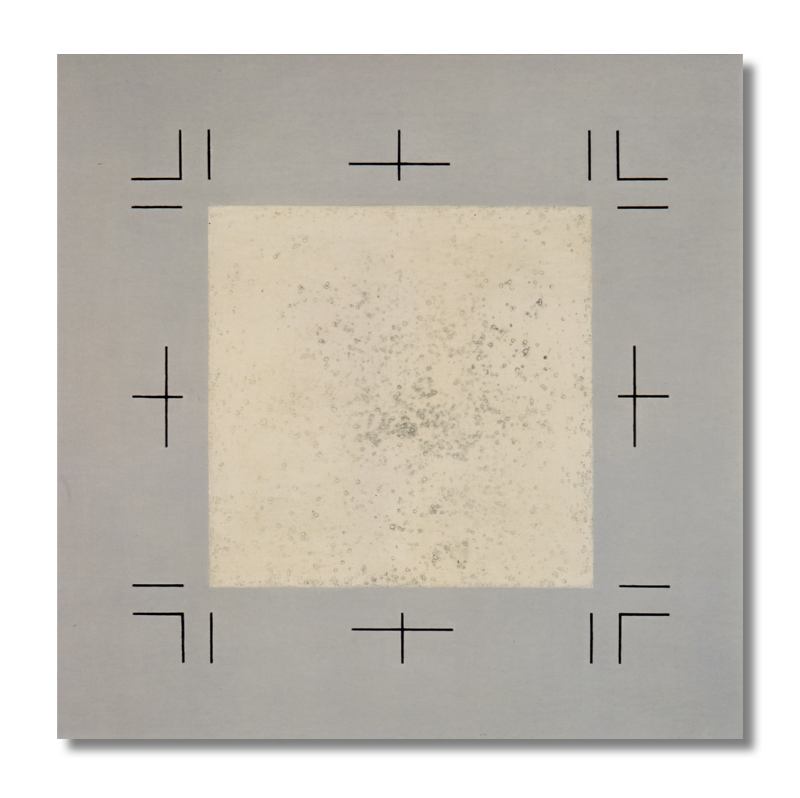1998 Carsten Ahrens
Thought Images of Painting
Carsten Ahrens // Thought Images of Painting
Scintillating planes of deeply iridescent color, abstract signs of an indecipherable language, ciphers which appear clothed as painting, painting which becomes a cipher. In the visual worlds of Sabine Straf3burger we move across a double-layered terrain. The multileveled color spaces of her paintings formulate a counterimage to a world whose rapid cuts exchange one visual surface for the next one.
Sabine Straßburger’s pictures are characterized by discreet reticence, cairn poles amid the storm of images which shoot across our retina day after day. This is a still depth which unfolds between the fixed poles of the color space of paint and the precise arrangements of characters. There arise complex structures which open passages between the multiple levels of perception from which we derive our image of the world.
In these last years Sabine Straf3burger has developed an artistic language which can stake its claim on the poetic space unfolded by her painting as weil as on the concise utilization of symbolic abstractions from the realm of theoretical reflection.
By looking back to the beginning of this way of making pictures, we can observe how precisely these visual constructions arc formulated. In die pictures at the beginning of the Nineties, there appear organic forms in thickly applied, monochrome layers of color which were often set one against the other and which represented a serial sequence of fragmented signs. We saw mysterious color spaces in which seemingly archaic figuration shone forth and receded like ciphers from another cra – campsites of a perished cultute or images from die other, die nocrurnal side of die present. Dream phantasms which flicker in many-tongued meaning across the colored surfaces – a roundelay of die ambiguous, fragile balance of our imaginings, images in which remembrance writes its ongoing text by means of the interwoven associations of die silent ciphers.
In recent years die artistic language of these pictures has attained a sharper contour through a stronger contrast between die poles of the painter’s piling on of color planes and die setting of abstract signs. The thick application technique gave way to what are more translucent levels of color. Skins of color bordering upon the diaphanous are laid one upon the other, so that planes are created which are just as permeable and sealed as a membrane. The stratification of these pictures becomes their historv, the history of artistic genesis. Time is stacked up in diese pictures; the radiate duration, stopping points to be gazed at, the concentration of our perception.
What does it mean to picture something to oneself? How do images arise inside our head, free from the stick-on pictures of that so-called visual communication which channels our inner representations into more and more one-dimensional conduits?

and 5 1994 86x130cm, 8-parts pigments, oil, paper / canvas
The pictures of Sabine Straßburger arc pictures of a painter who plays with pious assent to conventional codes and with unbroken trust in technical images. She is able to do this because right from the beginning her pictures allow the material of color to act against a system of signs. The product of this undertaking is a multi-layered system of highly diverse perceptual planes which arc woven into and weighed against each other. Through die punctuation of language systems, for example parendiesis, period and comma or plus and minus signs, a level of meaningful contents is written into die flow of die painting. The skin of the painting is in a certain sense tattooed with fragments of a code in which our longing for meaningfulness is dimly mirrored.
These pictures are fetching to the eye and challenging to die mind all at once – no dividing line can be drawn here – so diat one can shift into the other, our gaze may bring sometimes more, sometimes less trust to one or the other.
How is that we grant for more belief to a sentence than to a colored surface finely nuanced into the most diverse gradations of hue? Why do we cast into exil the interwoven associations immanent in the abstraction of a picture, toss them into die lying labyrinth of fantasy? And all the while we are much more inclined to nod in assent to the coded contents of a sequence of letters, insofar as we are not disturbed by the distortions of poetic constructs?
„We arc so caught up in the classical idea of die sufficiency of the intellect, “ states Maurice Merleau-Ponty in his lucid study „The Eye and the Mind“, „that this speechless thinking of painting occasionally creates in us die impression of a vacuous whirlpool of meanings, a paralyzed or failed language. And if one answers that no thinking separates itself from its carrier, that it is the only privilege of thinking in language to have made its own mode so manageable, that just as little as the forms of painting do those of literature and philosophy have die guarantee of collecting themselves in a stable treasure, that even natural science learns to recognize a zone of the fundamental which is densely populated by open and split beings and which one can in no way treat exhaustively, such as die aesthetic Information of die cyberneticists and mathematical-physical operation groups, and that we are finally nowhere able either to draw up an objective account or to think of progress itself [ … ]“

verin 1998 70x130cm, 2-parts oil, pigment/canvas
In this context Sabine Straßburger employs ever new experimental arrangements to situate within the picture the question as to why the illusion. within our perception are so steadfast and the fear of a terrain which knows no final answers is so large. Moving along this track, her painting formulates an ongoing criticism of the technical images which can claim for themselves the capability of deceiving the observer with a supposedly high content of truth. For in spite of knowledge about the possibility of manipulating electronically created pictures, that which is seen is understood to be real – all-powerful fantasies of an omnipresence which consists only of pixels „Photograph has destroyed the likeness, „observes Elias Canetti in his notes concerning „The Province of the Human“, yet painting has in no way abandoned the Vision of the artistic equivalent of the real.
Painting refuses to be an easily handled system of images, negates the comprehensibility of the world through images and thereby constructs an imaginary space beyond the coded systems which define our commonplace world of merchandise, the exchange of information, Gazing at the pictures of Sabine Straßburger, the observer is thrown back onto his own resources. The pictures send the observer onto a never-ending journey of clashes and contradictions – a journey which knows the goal of no harbor, for „1“ certainly always means „Another“; there is no such thing as a congruent image, a fixed image, an absolute identity.
What is special about the pictures of Sabine Straßburger is that they succeed in integrating signs of discursive language into the painted image without operating on the surface of excitingly staged disparities, in other words without grabbing after effects which quickly evaporate.
Upon a square picture surface, there appears a square which is sharply delineated against the gray surroundings – like a picture segment in which painting occurs. In yellowish colors the painted surface scintillates, mysterious phenomena appear like a will-o‘-the wisp, like a view into the hidden world of a stony crater. The many-voiced language of painting is framed by gray theory. On the borders of the picture the artist has set adjustment marks which in multi-colored offset printing assure that the various printing plates are precisely synchronized with each other. The adjusted illusion of the precise picture, the piercingly sharp depiction of reality – a mode of viewing which the artist claims for her picture through this contrecoup of her painting
With her pictures Sabine Straßburger formulates compositions of painting We see sequences of signs in their play of meaning. Following the principles of poetic construction, the signs become more dense, allow space in which our thoughts can dance the wild dance of concrete association – a space of freedom in which, without the tightly constricting garment of subject, predicate and object the world is seen without grammatical reading-glasses.
In diptychs, diverse color surfaces and various signs are contrasted with each other. There arc brackets, with which we normally indicate parentheses in sentence constructions or add subsidiary meanings without wishing to interrupt the flow of speech. When these brackets are cast into the flow of painting, they open up thought spaces or dose and consolidate a space which must remain empty. We encounter the idea of the circle, indicated by lines, cut mnto segments and distributed over several picture Formats – the idea of the circle as an absolute form is presented as a thought construction which must be carried out in our head and which is not delivered free of charge. Homogeneous pictures, archetvpal images of harmony – these are illusions which are real solely as constructs of ideas, as images of thought.
In a series of pictures die artist employs those protective coverings which arc turned up over the corners of frames to protect them from damage. On the one hand these forms arc actually utilized in serially arranged sequences of pictures, and on the other hand the form appears as a surface left blank, a space which painting does not fill. The district of painting is here imagined to be protected – but also set in brackets, demarcated from the surrounding space, marked off as artistic terrain.
These brackets would ha-ve to be nullified if reality were to Validate Antonin Artaud’s dream that an exhibition must be not only an event in art history but in history itself. But in point of fact we see that our perception of the world shatters into a multiplicity of moments. Every code develops its own image of the world.

scan 1998 135x135cm oil, pigment/canvas
Straßburger formuliert mit ihren Bildern Setzungen der Malerei. Wir sehen Zeichenfolgen, in denen der Sinn spielt. Poetischen Konstruktionsprinzipien folgend verdichten sich die Zeichen, geben Raum, in dem unsere Gedanken den wilden Tanz konkreter Assoziation tanzen können – ein Freiraum, in dem ohne das eng anliegende Gewand von Subjekt Prädikat Objekt, die Welt ohne grammatikalische Lesebrille gesehen wird.
In Diptychen werden unterschiedliche Farbflächen und unterschiedliche Zeichen gegeneinander gesetzt, Klammern, mit denen wir gewöhnlich in Satzkonstruktionen Parenthesen kenntlich machen oder Nebenbedeutungen hinzufügen ohne den Fluss der Rede unterbrechen zu wollen, sie eröffnen in den Fluss der Malerei ausgesetzt, Gedankenräume oder verschließen, verdichten einen Raum, der leer bleiben muss. Wir begegnen der Idee des Kreises, von Linien bezeichnet, zerschnitten in Segmente und auf mehrere Bildformate verteilt – die Idee des Kreises als absolute Form wird als Konstruktion des Gedankens vorgestellt, die in unserem Kopf zu leisten ist, nicht frei Haus geliefert wird. Homogene Bilder, Urbilder der Harmonie – sie sind Illusionen, die allein als Ideenkonstruktionen – als Gedankenbild real sind.
In einer Serie von Bildern verwendet die Künstlerin jene Schutzhüllen, die über die Ecken von Rahmen gestülpt werden, um sie vor Beschädigung zu bewahren. Diese Formen werden in seriell angeordneten Bildfolgen einmal real zum Einsatz gebracht, zum anderen erscheint die Form als ausgesparte Fläche, als Raum, den die Malerei nicht füllt. Der Bezirk der Malerei wird hier imaginär geschützt zum einen – aber auch eingeklammert, vom umgebenden Raum abgegrenzt, als künstlerisches Terrain markiert.
Diese Klammern würde es aufzulösen gelten, wenn Antonin Artauds Traum, dass eine Ausstellung nicht nur ein Ereignis in der Kunstgeschichte, sondern der Geschichte überhaupt sein müsse, an Realität gewinnen soll. Doch in realiter sehen wir, dass unsere Wahrnehmung der Welt in eine Vielzahl von Momenten zersplittert. Jeder Code entwickelt sein eigenes Weltbild.
In den homogenen Kontradiktionen ihrer Bilder konstruiert Sabine Straßburger eine geheime Melodie, wie sie vornehmlich die Malerei anzustimmen in der Lage ist. Poetische Präzision erzählt hier von einem weiteren Traum der Kunst, den Georg Simmel in folgenden Worten besungen hat: „So gehört dies überhaupt zu dem unbegreiflich Höchsten aller Kunst, dass sie Wertreihen, die im Leben gleichgültig, fremd oder feindlich auseinanderliegen, wie in selbstverständlicher Einheit zusammenführt […] und uns damit eine Ahnung und ein Pfand gibt, dass die Elemente des Lebens doch wohl in ihrem letzten Grunde nicht so heillos gleichgültig und beziehungslos nebeneinander liegen, wie das Leben selbst es glauben machen will.“
In the homogeneous contradictions of her pictures, Sabine Straßburger constructs a secret melody which painting is particularly capable of playing In poetic precision a tale is told about a further dream of art, which was besung by Georg Simmel with the following words: „Hence it is one of the highest achievements of all art to bring together into self-evident unity strings of values which in life lie apart in indifference, alienation or enmitv […] and to thereby give us an intuition and a pledge that the elements of life do not in their deepest nature lie next tu each other so irredeemably indifferent and unrelated as life itself would have us believe.“
Translated by George Frederick Takis
Maurice Mer1eau-Pont The Eye and the Mmd, Hamburg 1984, p.42 Ei. Elias Canetti, The Province of the Hurnaa Notes 1942-1972, Munich 1973), cited in: Frankfurt am Main 1973, p. 153 Georg Simmel, Concerning the Philosophy of the Actor, in lbid., The Individual Ln Frankturt am Main 1987, p. 90